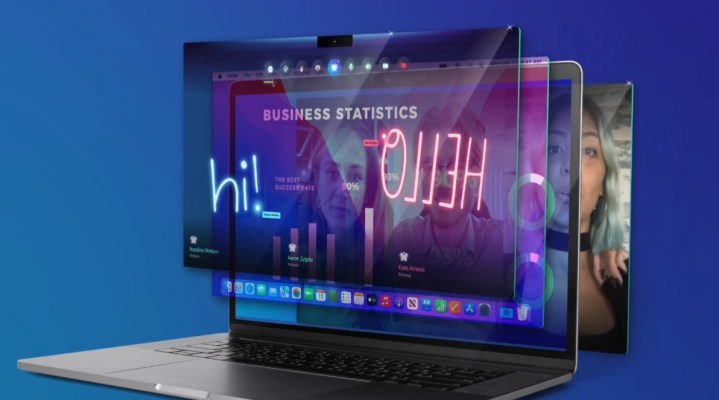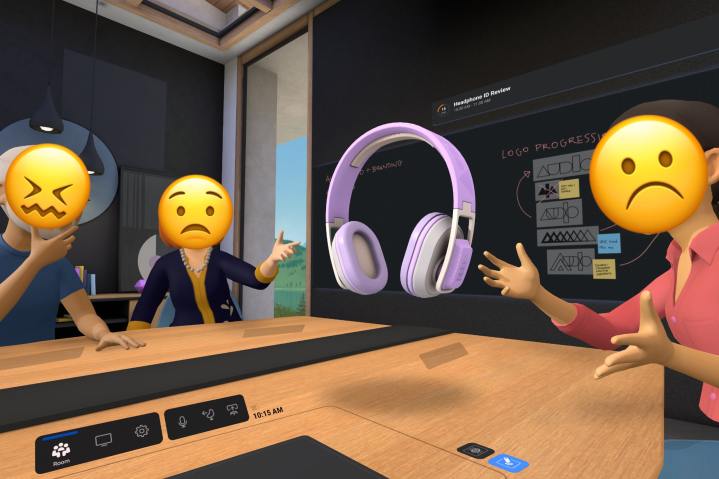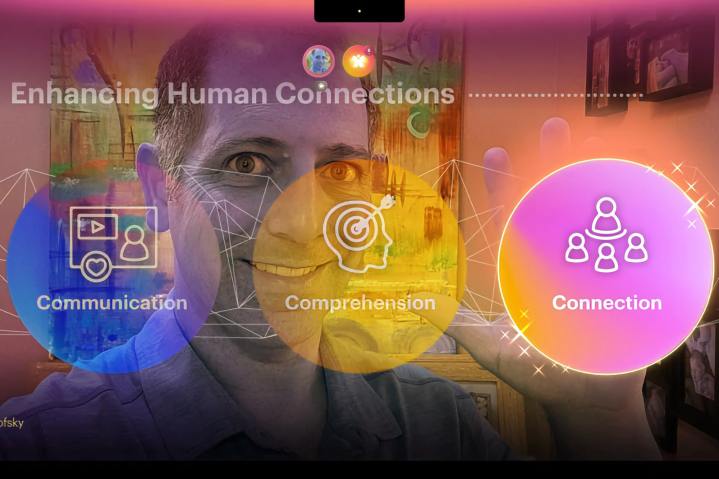Video calls have become a staple of the modern office, and they’re not going anywhere anytime soon. Companies like Meta want you to think mixed reality or virtual reality might make these meetings easier to stomach, but we all know those technologies don’t quite feel ready yet.
But the startup Mobeus has a different idea about how to improve video meetings — and it doesn’t involve any more hardware than the laptop you already own. I spoke with Mobeus’ Chief Experience Officer Alan Lepofsky about Airglass while testing out this new video conferencing software myself.

How is Airglass different?
Mobeus designed Airglass to be a much richer experience than a standard Zoom meeting. First of all, it’s a piece of software, and despite what it claims to do, no extra hardware is required. But once you’ve got the app open and start up a video call, you’ll find a very different interface than what you might be familiar with.
Instead of a wall of talking heads, Airglass focuses on just one to three people at a time, despite the fact that there can be as many as 60 participants in the meeting. When I tried Airglass, I could clearly see who was on the other side of the screen and they could see me in large vertical slices that filled the screen from top to bottom.
A meeting takes place in what Mobeus calls Glasstop, which is a workspace that brings to mind the AR interfaces seen in science fiction films. That means my desktop seemed to hover between me and the people I was chatting with, hand gestures could interact with the screen, and I could type and draw in glowing colors to emphasize a point or highlight an onscreen detail.
Despite having to familiarize myself with the new interfaces, I found myself surprisingly refreshed and engaged by the conversation — which is more than I can say about a standard Zoom call.
How Airglass works

When I launched the Airglass app, the screen was filled with the aptly named Glasstop interface. I could immediately see a barely visible, but full-screen view of myself from my MacBook’s webcam. At the same time, in a much more opaque form, a contacts list appeared along with controls to start a meeting, change video and audio settings, or start recording. The default translucency shows about 15% of the webcam view mixed with 85% of your regular computer screen.
This is adjustable with a slider, making it easy to fade the webcam in to see yourself or others once a meeting begins, and out when you want to concentrate more on an app or webcam controls. If you are the presenter, you can invite people to join and select how many are visible in up to three vertical panes as well as control the translucency of your desktop and apps.
The most immersive experience is at 50% translucency so you can see both the screen being shared and the people that are speaking in a large full-screen view. The idea is to make a meeting, even with dozens of attendees feel more personal.
The presenter has the option to take control, sharing their screen and controlling translucency. As a participant, I wasn’t locked out of my computer, however. I could simply move my mouse pointer to change back to my desktop. When that happens, the speakers’ webcams are still visible in small circles that Mobeus calls Teleports.
This type of flexibility is seen throughout the app and anyone can share their screen. When screen sharing stopped, my own desktop became visible and I could still see the other meeting participants.
If transparency hasn’t been locked, it can be adjusted so the webcam view can be completely opaque, completely hidden, or somewhere in between. That means you can easily take notes and look up relevant data to contribute to the meeting. Alternatively, you can multitask, work on other products, or even browse the web during a casual meeting.
AR Features without extra hardware

Beyond the translucent Glasstop and a three-way split view of speakers, there are thoughtful extras throughout the software. The real magic comes with some clever AR features. Hand gestures are recognized and this works with regular computer webcams. A presenter can raise a hand to see it outlined on the screen and the virtual hand can be used to highlight parts of the screen or move from one slide to the next.
The controls are easily accessible by selecting the Airglass menu that stays at the top center or you can use a variety of keyboard shortcuts to control everything without reaching for the mouse.
Airglass isn’t just limited to your webcam, though. You can easily select a different camera, even a wireless camera. Since hand gestures can be used to control the app, you can be walking around holding your smartphone or presenting on a stage while paging through PowerPoint slides, all while keeping eye contact and gauging reactions.
What’s needed?

Like Zoom, Microsoft Teams, and many other video conferencing apps, you need to install Airglass to take advantage of its unique features. The software is initially available for macOS and Windows with a mobile app in progress.
You obviously need a webcam, but expensive AR glasses and VR headsets are not needed to take advantage of this futuristic meeting app. It works on almost any laptop or desktop computer.
Airglass beats other meetings

Compared to a standard online meeting in Zoom, Microsoft Teams, or Google Meet, Airglass feels like the future. It’s a refreshing take that mixes video chats, screen sharing, online whiteboards, and augmented reality features.
Mobeus reinvented team meetings without the need for VR headsets or AR glasses. Perhaps virtual and augmented reality will become easier and more accessible in the future, but for now, Airglass might be the solution we’ve been waiting for that makes working from home and telecommuting more personal and productive. It will take a lot for companies to move away from well-established applications like Teams or Zoom, but the technology here is certainly onto something interesting.
If you want to learn more, you can check out the Mobeus website to learn more and download Airglass for yourself. A subscription is required and it’s $14.95 per month. There’s also an annual plan if you anticipate using Airglass regularly.
Editors’ Recommendations





